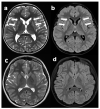"Spazio Huntington": Tracing the Early Motor, Cognitive and Behavioral Profiles of Kids with Proven Pediatric Huntington Disease and Expanded Mutations > 80 CAG Repeats
- PMID: 35055435
- PMCID: PMC8778418
- DOI: 10.3390/jpm12010120
"Spazio Huntington": Tracing the Early Motor, Cognitive and Behavioral Profiles of Kids with Proven Pediatric Huntington Disease and Expanded Mutations > 80 CAG Repeats
Abstract
The "Spazio Huntington-A Place for Children" program was launched in 2019. The aim was to contact at risk kids within Huntington disease (HD) families, to provide counseling to their parents and to start a prospective follow-up of kids suspicious to manifest pediatric HD (PHD). We met 25 at risk kids in two years, four of whom with PHD and highly expanded (HE) mutations beyond 80 CAG repeats. We rated motor, neuropsychological and behavioral changes in all PHD kids by the Unified HD Rating Scale (UHDRS)-total motor score (TMS) and additional measures of (1) cognitive level (Leiter International Performance Scale), (2) adaptive functioning (Adaptive Behavior Assessment Systems), (3) receptive language (Peabody Picture Vocabulary Test) and (4) behavioral abnormalities (Child Behavior Check List and Children's Yale-Brown Obsessive Compulsive Scale). All PHD kids showed a severe progression of neurological and psychiatric manifestations including motor, cognitive and behavioral changes. The magnetic resonance imaging contributed to confirm the suspicious clinical observation by highlighting very initial striatum abnormalities in PHD. Spazio Huntington is a program to prospectively study PHD, the most atypical face of HD, and may represent the basis to recruit PHD patients in future clinical trials.
Keywords: atypical Huntington disease; high CAG expansions; observational studies; pediatric Huntington disease; prospective studies.
Conflict of interest statement
The authors declare no conflict of interest.
Figures



References
-
- MacDonald M.E., Ambrose C.M., Duyao M.P., Myers R.H., Lin C., Srinidhi L., Barnes G., Taylor S.A., James M., Groot N., et al. The Huntington’s Disease Collaborative Research Group: A novel gene containing a trinucleotide repeat that is expanded and unstable on Huntington’s disease chromosomes. Cell. 1993;72:971–983. doi: 10.1016/0092-8674(93)90585-E. - DOI - PubMed
-
- Quarrell O.W.J., Brewer H.M., Squitieri F., Barker R.A., Nance M.A., Landwehrmeyer G.B., editors. Juvenile Huntington’s Disease. Oxford University Press; Oxford, UK: 2009.
-
- Ghosh R., Tabrizi S.J. Clinical Features of Huntington’s Disease. In: Nóbrega C., Pereira de Almeida L., editors. Polyglutamine Disorders. Volume 1049. Springer; Cham, Switzerland: 2018. - DOI
-
- Squitieri F., Berardelli A., Nargi E., Castellotti B., Mariotti C., Cannella M., Lavitrano M.L., De Grazia U., Gellera C., Ruggieri S. Atypical movement disorders in the early stages of Huntington’s disease: Clinical and genetic analysis. Clin. Genet. 2000;58:50–56. doi: 10.1034/j.1399-0004.2000.580108.x. - DOI - PubMed
Grants and funding
LinkOut - more resources
Full Text Sources
Miscellaneous

